Deploying Coro via Atera
This guide describes how to deploy the Coro Agent to your endpoint devices through the Atera remote monitoring and management (RMM) platform.
To deploy Coro to endpoint devices via the Atera RMM platform, you need to:
Prerequisites
Before you begin this guide, make sure you have:
- An active Coro subscription
- Coro Agent version 2.5.60.1 (3.1) or later installed on your device
- An Atera administration account
- Access to the Atera RMM platform
- Devices listed and ready for Coro deployment in the Atera RMM platform
Obtaining the Coro deployment script
Coro provides the following Windows PowerShell deploy script to enable organizations to install the Coro Agent on their Windows endpoint devices using Atera RMM:
Expand for more details
#Please add Coro installation URL and msi package name below (in between quotes "")
$url = "Please add Coro installation URL here and don't delete the quotes"
$newFilename = "Please add the name of Coro msi package here from the url, without deleting the quotes. For example, CoroInstaller_1b16c978-cd39-49bf-8809-7b4e87227e4e.msi"
#Variables
$softwareName = "Coro"
$logFilePath = "C:\Windows\Temp\CoroInstallerlog.txt"
#Display OS version
try {
Write-Host ""
Write-Host ""
$operatingSystem = Get-CimInstance -ClassName Win32_OperatingSystem
$osVersion = $operatingSystem.Version
$osEdition = $operatingSystem.Caption
$osArchitecture = $operatingSystem.OSArchitecture
$OSVersion = "$osEdition $osArchitecture $osVersion"
Write-Host "$OSVersion"
} catch {
}
#Define msi file location
$msiFilePath = "C:\Windows\Temp\$newFilename"
#Download Coro installer
Write-Host ""
Write-Host "Downloading $newFilename file"
Write-Host "This might take some time, depending on download speed"
$webClient = New-Object System.Net.WebClient
try {
$webClient.DownloadFile($url, $msiFilePath)
Write-Host "Done! The file placed in C:\Windows\Temp" -ForegroundColor Green
} catch {
Write-Host "Error when downloading. Error message: $($_.Exception.Message)" -ForegroundColor Cyan
Write-Host "Please contact Support and send a screenshot of this output" -ForegroundColor Cyan
Start-Sleep -Seconds 5
exit 1
}
$webClient.Dispose()
#Install the downloaded file
try {
Write-Host ""
Write-Host "Installing $softwareName"
$coroInstall = Start-Process msiexec.exe -PassThru -Wait -ArgumentList "/i `"$msiFilePath`" /qn /L*V `"$logFilePath`""
$exitCode = $coroInstall.ExitCode
if ($exitCode -eq 0) {
Write-Host "Done!" -ForegroundColor Green
Start-Sleep -Seconds 1
$success = $true
} elseif ($exitCode -eq 1619) {
Write-Host "Installation failed because of value of msiFilePath variable" -ForegroundColor Cyan
Write-Host "Error code: $exitCode" -ForegroundColor Cyan
Write-Host "Please contact Support and send $logFilePath log file along with a screenshot of this output" -ForegroundColor Cyan
Remove-Item -Path $msiFilePath -Force -Confirm:$false
Start-Sleep -Seconds 10
exit 1
} elseif ($exitCode -eq 1639) {
Write-Host "Installation failed because of incorrect argument(s) (-ArgumentList in coroInstall variable)" -ForegroundColor Cyan
Write-Host "Error code: $exitCode" -ForegroundColor Cyan
Write-Host "Please contact Support and send a screenshot of this output" -ForegroundColor Cyan
Remove-Item -Path $msiFilePath -Force -Confirm:$false
Start-Sleep -Seconds 10
exit 1
} else {
Write-Host "Installation failed, error code: $exitCode" -ForegroundColor Cyan
Write-Host "Please contact Support and send $logFilePath log file along with a screenshot of this output" -ForegroundColor Cyan
Remove-Item -Path $msiFilePath -Force -Confirm:$false
Start-Sleep -Seconds 10
exit 1
}
} catch { }
#Display success message
if ($success -eq $true) {
Remove-Item -Path $logFilePath -Force -Confirm:$false
Remove-Item -Path $msiFilePath -Force -Confirm:$false
Write-Host ""
Write-Host "Deleting installation and log files as these are no longer required"
Write-Host "All done, $softwareName is now installed" -ForegroundColor Green
Start-Sleep -Seconds 5
} else { }In this script, replace the following markers with real values:
- $url : The download URL for the latest version of the Coro Agent installer for Windows, obtained from the Coro console. For details, see Deploying Coro on windows endpoints .
- $msiFilePath : The unique installer .msi filename embedded in the download URL.

For example, if the download URL is:
https://s3.amazonaws.com/client-repo.coro.net/beta/win/releases/2.0.412.1/CoroInstaller.msi?response-content-disposition=attachment%3B%20filename%3DCoroInstaller_123abc-456def-789abc.msi&AWSAccessKeyId=AKIA5XP6&Signature=y4V3Tq2dU9mE%3D&Expires=2005954595
The installer filename (shown in bold) is then used within the shell script as per the following example:
$newFilename = CoroInstaller_123abc-456def-789abc.msi

Important
Make sure you do not delete the quotations when replacing the placeholder text for $url and $msiFilePath.
note
If you manage multiple workspaces you must create a copy of the standard Coro deployment script and repeat this process for each workspace.
Adding the Coro deployment script to Atera
To add your Coro deployment script to the Atera RMM platform, perform the following steps:
- Sign in to the Atera RMM platform using an administrator account.
-
Select
New
, and then select
Script
:
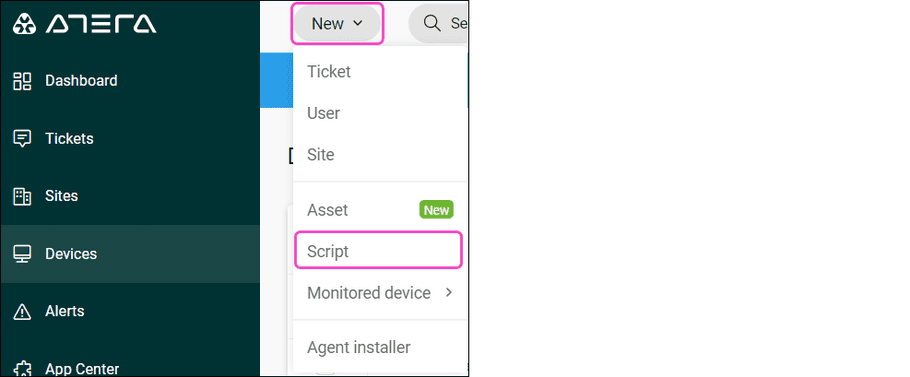
The Create script dialog appears.
-
Enter the following new script information:
Field Description Script Name Enter a suitable script name, for example, "Coro_Deployment". File type Select ".ps1". Script Description Enter a suitable script description, for example, "This script deploys the Coro Agent on specified devices." 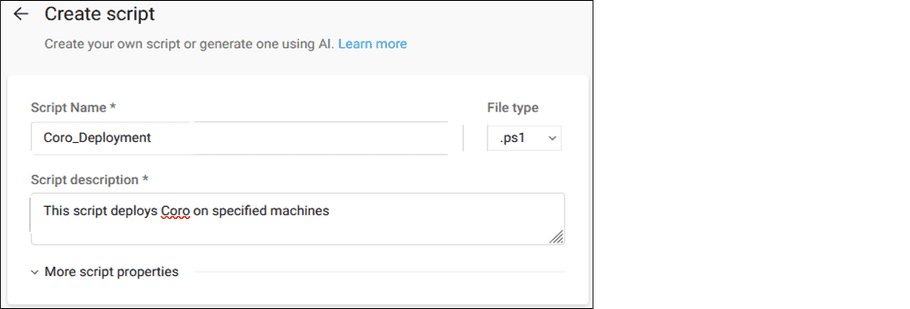
-
Expand
More script properties
, and then enter the following additional script information:
Field Description Category Leave blank. Max script run time (minutes) Enter "10". Arguments Leave blank. Run as Select System. 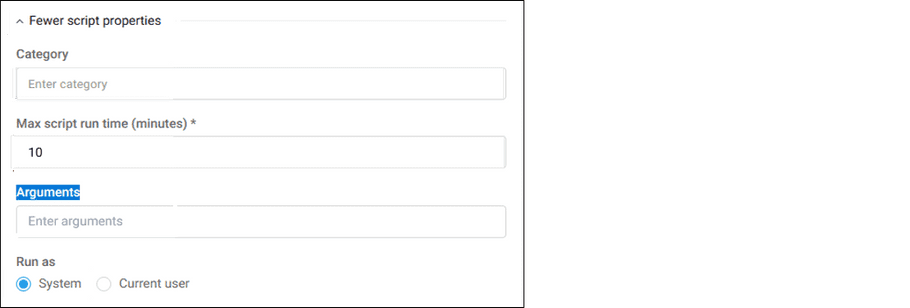
-
Copy and paste your
Coro deployment script
into the
Script editor
:
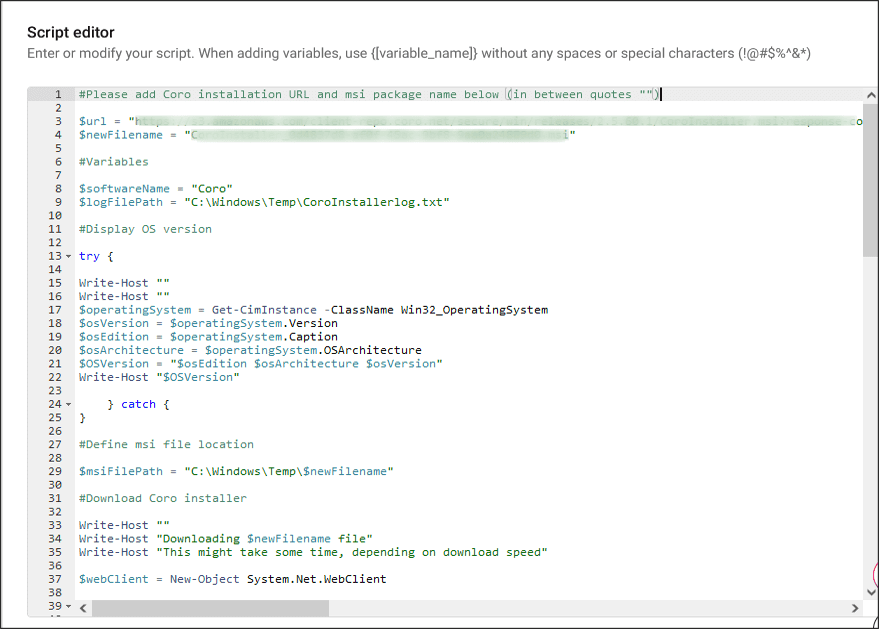
-
Select
Create
:

Atera creates the deployment script, and it appears on the My Scripts tab on the Scripts page, ready for deployment:

Deploying Coro
To deploy the Coro Agent on selected endpoint devices using the deployment script, perform the following steps:
- Sign in to the Atera RMM platform using an administrator account.
-
Go to
Devices
:
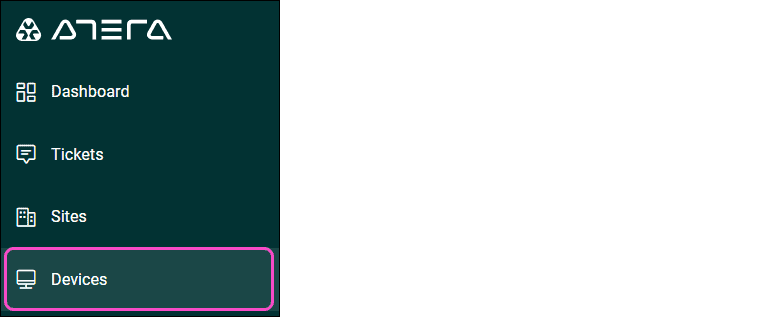
A list of all devices appears.
-
Select the checkbox next to each device on which you want to deploy the Coro Agent, and then select
Run Script
:

The Run script on devices dialog appears:

-
From the
My Scripts
tab, select
Run
, located next to the Coro deployment script:

The deployment script executes and a notification appears:

-
To monitor the progress of the script deployment, go to
Reports
>
Classic Reports
>
Recent Processes
:
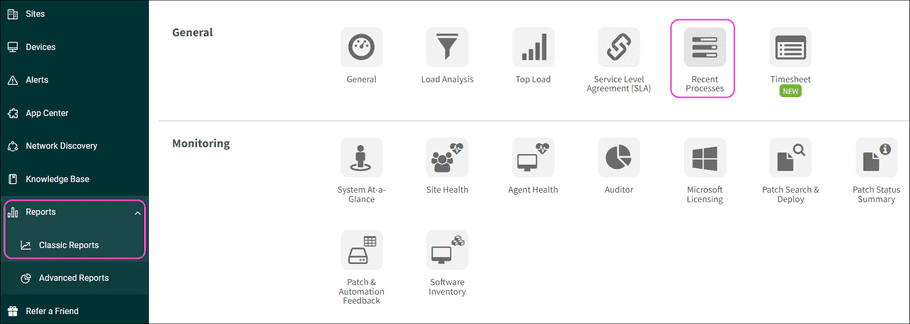
The Current Status displays "In Progress":

The Coro Agent is deployed on the selected devices.
After script deployment, the Current Status changes to "Ended".
-
Hover over
?
to view the script deployment result:

A result of 1 Completed confirms successful deployment.
Uninstalling Coro via Atera
Important
Make sure you disable Tamper Protection in your Coro Workspace before attempting to uninstall Coro.
To uninstall Coro from endpoint devices via the Atera RMM platform, you need to:
Prerequisites
Before you begin this guide, make sure you have:
- An active Coro subscription
- An Atera administration account
- Access to the Atera RMM platform
Obtaining the Coro uninstall script
Coro provides the following Windows PowerShell uninstall script to enable organizations to remove the Coro Agent from their Windows endpoint devices using Atera RMM:
Expand for more details
#Elevate the script, if not elevated
$elevated = ([Security.Principal.WindowsPrincipal] [Security.Principal.WindowsIdentity]::GetCurrent()).IsInRole([Security.Principal.WindowsBuiltInRole]"Administrator")
if (-not $elevated) {
try {
Write-Host "This Powershell instance is not elevated. Elevating now..."
$args = "-ExecutionPolicy Bypass", "-File `"" + $myinvocation.MyCommand.Path + "`" " + $myinvocation.UnboundArguments
Start-Process powershell -Verb runAs -ArgumentList $args
exit
} catch {
Write-Host "Error while trying to elevate: $($_.Exception.Message) (Error code: $($_.Exception.HResult))" -ForegroundColor Cyan
Write-Host""
Write-Host"The script requires elevated permissions, please run it as Administrator" -ForegroundColor Cyan
Start-Sleep -Seconds 3
exit 1
}
} else {
Write-Host ""
Write-Host "This instance is now elevated, proceeding to the next step"
Write-Host ""
}
#Display OS version
try {
$operatingSystem = Get-CimInstance -ClassName Win32_OperatingSystem
$osVersion = $operatingSystem.Version
$osEdition = $operatingSystem.Caption
$osArchitecture = $operatingSystem.OSArchitecture
$OSVersion = "$osEdition $osArchitecture $osVersion"
Write-Host "$OSVersion"
Write-Host ""
} catch {
}
#Set variables
$global:outputTimestamp = Get-Date -Format "dd-MM-yyyy HH:mm"
$global:outputSpace = " " * 18
Write-Host "[$outputTimestamp] Configuring variables (might take some time...)"
$packageToDelete = "Coro*"
$softwareName = "Coro"
$tamperPath = "HKLM:\SOFTWARE\Coro Cyber Security Ltd\Coro"
$tamperValue = "SelfProtected"
$uninstallPath32 = "HKLM:\Software\Wow6432Node\Microsoft\Windows\CurrentVersion\Uninstall\*"
$registryResult32 = Get-ItemProperty -Path $uninstallPath32 | Where-Object { $_.DisplayName -like $packageToDelete }
$uninstallPath64 = "HKLM:\Software\Microsoft\Windows\CurrentVersion\Uninstall\*"
$registryResult64 = Get-ItemProperty -Path $uninstallPath64 | Where-Object { $_.DisplayName -like $packageToDelete }
$valueReg64 = $registryResult64.UninstallString
$match = [regex]::Match($valueReg64, '\{[^}]+\}')
if ($match.Success) {
$uninstallStringReg64 = $match.Value
} else { }
try {
$packageResult = Get-Package | Where-Object { $_.Name -like $packageToDelete }
} catch {
}
try {
$wmiResult = Get-WmiObject -Class Win32_Product | Where-Object { $_.Name -like $packageToDelete }
if ($wmiResult -ne $null) {
$wmiIdentifyingNumber = $wmiResult.IdentifyingNumber
$wmiValue = $true
} else {
}
} catch {
}
Write-Host "$outputSpace Done!" -ForegroundColor Green
#Check if Coro is installed
function Check-Installed {
Write-Host "[$outputTimestamp] Detecting $softwareName"
$installed = $false
if ($registryResult32 -or $registryResult64 -or $packageResult -or $wmiResult) {
$installed = $true
Write-Host "$outputSpace Done!" -ForegroundColor Green
} elseif (Test-Path "C:\Program Files\Coro Cyber Security Ltd\Coro\user\Coro.exe") {
$installed = $true
Write-Host "$outputSpace Done!" -ForegroundColor Green
} else {
Write-Host "$outputSpace $softwareName is not installed. The script will terminate now." -ForegroundColor Cyan
Start-Sleep -Seconds 5
exit 1
}
return $installed
}
$installed = Check-Installed
#Detecting Safe Mode
Write-Host "[$outputTimestamp] Checking if the OS is running in Safe Mode"
$safeMode = $false
try {
$safeModeDetector = (gwmi win32_computersystem -Property BootupState).BootupState
if ($safeModeDetector -ne "Normal boot") {
$safeMode =$true
} else {
$safeMode =$false
}
} catch {
Write-Warning "Error checking safe mode: $_"
}
if ($safeMode -eq $false) {
Write-Host "$outputSpace Not in Safe Mode" -ForegroundColor Green
} else {
Write-Host "$outputSpace Safe Mode detected" -ForegroundColor DarkYellow
}
#Check for potential corruption
if ($installed -eq "true" -and $safeMode -eq $false) {
Write-Host "[$outputTimestamp] Checking Coro's integrity"
$registryValue = Get-ItemProperty -Path $tamperPath -Name $tamperValue -ErrorAction SilentlyContinue
if ($registryValue -and $registryValue.$tamperValue -eq "true") {
$TamperProtectionON = $true
} else {
$TamperProtectionON = $false
} } else {}
if ($installed -eq "true" -and $safeMode -eq $false) {
if ($TamperProtectionON -eq $true) {
$service1 = Get-Service "CoroAgent1SRV"
$service2 = Get-Service "CoroAgent2SRV"
if ($service1.Status -eq "Running" -and $service2.Status -eq "Running") {
Write-Host "$outputSpace Done!" -ForegroundColor Green
} else {
Write-Host "$outputSpace Coro services are not running. Attempting to start them..." -ForegroundColor DarkYellow
sc.exe config $service1 start=auto 2>1 1>2 | Out-Null
sc.exe config $service2 start=auto 2>1 1>2 | Out-Null
Start-Service $service1, $service2 -ErrorAction SilentlyContinue -WarningAction SilentlyContinue 2>1 1>2 | Out-Null -ErrorAction SilentlyContinue
Start-Sleep -Seconds 3
if ($service1.Status -eq "Running" -and $service2.Status -eq "Running") {
Write-Host "$outputSpace Done!" -ForegroundColor Green
} else {
sc.exe config $service1 start=auto 2>1 1>2 | Out-Null
sc.exe config $service2 start=auto 2>1 1>2 | Out-Null
Start-Service $service1, $service2 -ErrorAction SilentlyContinue -WarningAction SilentlyContinue 2>1 1>2 | Out-Null -ErrorAction SilentlyContinue
Start-Sleep -Seconds 3
if ($service1.Status -ne "Running" -and $service2.Status -ne "Running") {
Write-Host "$outputSpace A potential integrity corruption is detected" -ForegroundColor Cyan
Write-Host ""
Write-Host "$outputSpace Tamper Protection: ON | Coro Agent1 and Coro Agent2 services: Stopped" -ForegroundColor Cyan
Write-Host "$outputSpace Could not start Coro Agent1 and Coro Agent2 services" -ForegroundColor Cyan
Write-Host ""
Write-Host "$outputSpace Please boot Windows into Safe Mode and re-run this script again" -ForegroundColor Cyan
Write-Host ""
Start-Sleep -Seconds 3
exit 1
} elseif ($service1.Status -ne "Running" -and $service2.Status -eq "Running") {
Write-Host "$outputSpace A potential integrity corruption is detected" -ForegroundColor Cyan
Write-Host ""
Write-Host "$outputSpace Tamper Protection: ON | Coro Agent1 service: Stopped" -ForegroundColor Cyan
Write-Host "$outputSpace Could not start Coro Agent1 service" -ForegroundColor Cyan
Write-Host ""
Write-Host "$outputSpace Please boot Windows into Safe Mode and re-run this script again" -ForegroundColor Cyan
Write-Host ""
Start-Sleep -Seconds 3
exit 1
} elseif ($service1.Status -eq "Running" -and $service2.Status -ne "Running") {
Write-Host "$outputSpace A potential integrity corruption is detected" -ForegroundColor Cyan
Write-Host ""
Write-Host "$outputSpace Tamper Protection: ON | Coro Agent2 service: Stopped" -ForegroundColor Cyan
Write-Host "$outputSpace Could not start Coro Agent2 service" -ForegroundColor Cyan
Write-Host ""
Write-Host "$outputSpace Please boot Windows into Safe Mode and re-run this script again" -ForegroundColor Cyan
Write-Host ""
Start-Sleep -Seconds 3
exit 1
} else {
Write-Host "$outputSpace Done!" -ForegroundColor Green
Start-Sleep -Seconds 1
}
}
}
} else {
Write-Host "$outputSpace Done!" -ForegroundColor Green
}
} else {}
#Check Tamper Protection status
if ($installed -eq "true" -and $safeMode -eq $false) {
Write-Host "[$outputTimestamp] Detecting Tamper Protection status"
$registryValue1 = Get-ItemProperty -Path $tamperPath -Name $tamperValue -ErrorAction SilentlyContinue
if ($registryValue1 -and $registryValue1.$tamperValue -eq "true") {
Write-Host ""
Write-Host "Tamper Protection is enabled. It needs to be disabled for Coro to uninstall" -ForegroundColor Cyan
Write-Host ""
Write-Host "Please do the following to disable it:"
Write-Host ""
Write-Host "1. Login to your Coro Workpsace and navigate to Control Panel - Devices - Settings section."
$text = "2. Untick the Tamper Protection box. It will push the changes to the machine in question as per Heartbeat interval time.`r`n The Heartbeat interval time is located just above the Tamper Protection box and the default value is 7 minutes."
Write-Host $text
Write-Host "3. Retry the script afterwards."
Write-Host ""
Write-Host "In addition to the steps above, please also check the status of Coro Agent on the machine in question."
Write-Host "If it shows 'Protection disabled by Admin' message, you will also need to complete the steps below:"
Write-Host ""
Write-Host "1. Login to your Coro Workspace and navigate to Control Panel - Endpoint Security - NGAV section."
Write-Host "2. Make sure both 'Real-Time Malware' and 'Ransomware Protection and Advanced Threat Control' boxes are ticked."
Write-Host "3. If they are already ticked, make sure the device in question is added to the label under Advanced Threat Control section."
Write-Host "4. After that, please navigate to Control Panel - Activity Log section."
Write-Host "5. Find the entry that says 'Endpoint Protection for (The Name of The Device in Question) has been disabled'"
Write-Host "6. Click to Undo button to revert the changes. Please contact Support if the Undo button is greyed out."
Write-Host "7. Wait for it to push the changes as per Heartbeat interval time."
Write-Host "8. Once pushed, the status of the Coro Agent on the machine in question will change to 'Protected'."
Write-Host "9. Retry the script afterwards."
Write-Host ""
Write-Host "Please contact Support if you require any assistance with this"
Write-Host ""
Write-Host "The script will now terminate as it cannot proceed when Tamper Protection is enabled" -ForegroundColor Cyan
Start-Sleep -Seconds 30
exit 1
} else {
Write-Host "$outputSpace Disabled" -ForegroundColor Green
}
} else {
}
#Detect and stop Coro services
if ($installed -eq "true") {
Write-Host "[$outputTimestamp] Detecting and stopping $softwareName services"
$services = Get-Service -DisplayName "$packageToDelete"
if ($services) {
$failedServices = @()
foreach ($service in $services) {
$service | Stop-Service -Force -WarningAction SilentlyContinue -ErrorVariable err 2>&1 | Out-Null
if($err) {
$failedServices += [PSCustomObject]@{
Name = $service.Name
Error = $err[0].Exception.Message
}
}
}
if($failedServices) {
foreach ($fail in $failedServices) {
Write-Host "$outputSpace $($fail.Error)" -ForegroundColor Red
}
}
else {
Write-Host "$outputSpace Done!" -ForegroundColor Green
}
}
else {
Write-Host "$outputSpace Couldn't detect $softwareName services" -ForegroundColor Cyan
Write-Host "$outputSpace The script will carry on"
}
} else {
}
#Uninstall Coro
if ($installed -eq "true") {
Write-Host "[$outputTimestamp] Uninstalling $softwareName"
try {
if ($wmiValue -eq $true -and $safeMode -eq $false) {
Write-Host "$outputSpace ...using uninstalledWmi method"
try {
$uninstalledWmi = Start-Process msiexec.exe -PassThru -Wait -ArgumentList "/x $wmiIdentifyingNumber /qn"
$exitCodeWmi = $uninstalledWmi.ExitCode
if ($exitCodeWmi -eq 0) {
Write-Host "$outputSpace Done!" -ForegroundColor Green
$reboot = $true
$wmiMethodSuccess = $true
} elseif ($exitCodeWmi -eq 1619) {
Write-Host "$outputSpace wmiIdentifyingNumber not found but the script will carry on" -ForegroundColor Cyan
} elseif ($exitCodeWmi -eq 1639){
Write-Host "$outputSpace uninstalledWmi method failed as arguments (/qn) are wrong but the script will carry on" -ForegroundColor Cyan
} elseif ($exitCodeWmi -eq 1618){
Write-Host "$outputSpace $softwareName cannot be uninstalled because another installation is in progress" -ForegroundColor Cyan
Write-Host "$outputSpace Complete that installation or reboot your machine and execute this script again" -ForegroundColor Cyan
Write-Host "$outputSpace The script will now terminate as it cannot uninstall $softwareName" -ForegroundColor Cyan
Start-Sleep -Seconds 5
exit 1
} elseif ($exitCodeWmi -eq 1614) {
Write-Host "$outputSpace $softwareName cannot be uninstalled because another installation is in progress" -ForegroundColor Cyan
Write-Host "$outputSpace Complete that installation or reboot your machine and execute this script again" -ForegroundColor Cyan
Write-Host "$outputSpace The script will now terminate as it cannot uninstall $softwareName" -ForegroundColor Cyan
Start-Sleep -Seconds 5
exit 1
} elseif ($exitCodeWmi -eq 1720) {
Write-Host "$outputSpace uninstalledWmi: There is a problem with the Windows Installer package but the script will attempt to carry on" -ForegroundColor Cyan
} elseif ($exitCodeWmi -eq 1619) {
Write-Host "$outputSpace uninstalledWmi: The installation package could not be opened but the script will attempt to carry on" -ForegroundColor Cyan
} else {
Write-Host "$outputSpace uninstalledWmi method didn't work: $exitCodeWmi" -ForegroundColor Cyan
Write-Host "$outputSpace But the script will try the next uninstall method" -ForegroundColor Cyan
}
} catch { }
} else { }
} catch { }
try {
if ($wmiMethodSuccess -ne $true -and $safeMode -eq $false) {
try {
Write-Host "$outputSpace ...trying to uninstall using uninstalledReg64 method"
$uninstalledReg64 = Start-Process msiexec.exe -PassThru -Wait -ArgumentList "/x $uninstallStringReg64 /qn"
$ExitCodeReg64 = $uninstalledReg64.ExitCode
if ($ExitCodeReg64 -eq 0) {
Write-Host "$outputSpace Done!" -ForegroundColor Green
$reboot = $true
$uninstalledReg64MethodSuccess = $true
} elseif ($ExitCodeReg64 -eq 1619) {
Write-Host "$outputSpace uninstallStringReg64 not found but the script will carry on" -ForegroundColor Cyan
} elseif ($ExitCodeReg64 -eq 1639){
Write-Host "$outputSpace uninstalledReg64 method failed as arguments (/qn) are wrong. The script will carry on" -ForegroundColor Cyan
} elseif ($ExitCodeReg64 -eq 1618){
Write-Host "$outputSpace $softwareName cannot be uninstalled because another installation is in progress" -ForegroundColor Cyan
Write-Host "$outputSpace Complete that installation or reboot your machine and execute this script again" -ForegroundColor Cyan
Write-Host "$outputSpace The script will now terminate as it cannot uninstall $softwareName" -ForegroundColor Cyan
Start-Sleep -Seconds 5
exit 1
} elseif ($ExitCodeReg64 -eq 1614) {
Write-Host "$outputSpace $softwareName cannot be uninstalled because another installation is in progress" -ForegroundColor Cyan
Write-Host "$outputSpace Complete that installation or reboot your machine and execute this script again" -ForegroundColor Cyan
Write-Host "$outputSpace The script will now terminate as it cannot uninstall $softwareName" -ForegroundColor Cyan
Start-Sleep -Seconds 5
exit 1
} elseif ($ExitCodeReg64 -eq 1720) {
Write-Host "$outputSpace uninstalledReg64: There is a problem with the Windows Installer package. The script will carry on" -ForegroundColor Cyan
} elseif ($ExitCodeReg64 -eq 1619) {
Write-Host "$outputSpace uninstalledReg64: The installation package could not be opened. The script will carry on" -ForegroundColor Cyan
} else {
Write-Host "$outputSpace uninstalledReg64 method didn't work: $ExitCodeReg64" -ForegroundColor Cyan
Write-Host "$outputSpace But the script will try the next uninstall method" -ForegroundColor Cyan
}
} catch { }
}
} catch { }
try {
if ($wmiMethodSuccess -ne $true -and $uninstalledReg64MethodSuccess -ne $true) {
Write-Host "$outputSpace ...using alternative uninstall method"
#Kill Coro process from Task Manager
taskkill /IM coro-notifications.exe /F > $null 2>&1
taskkill /IM coro.exe /F > $null 2>&1
#Delete Coro entries from HKLM:\System\CurrentControlSet\Services hive
$name = "*Coro*"
Get-ChildItem "HKLM:\System\CurrentControlSet\Services" | ForEach-Object {
if ($_.PSChildName -like $name) {
Remove-Item -Path "Registry::HKEY_LOCAL_MACHINE\System\CurrentControlSet\Services\$($_.PSChildName)" -Recurse -Force -ErrorAction SilentlyContinue
}
}
#Delete Coro entries from HKLM:\SOFTWARE\Classes\Installer\Products hive
Get-ChildItem "HKLM:\SOFTWARE\Classes\Installer\Products" | ForEach-Object {
$values1 = Get-ItemProperty -Path "Registry::HKEY_LOCAL_MACHINE\SOFTWARE\Classes\Installer\Products\$($_.PSChildName)"
if(($values1.PSObject.Properties | Where-Object { $_.Value -match $softwareName })) {
Remove-Item -Path "Registry::HKEY_LOCAL_MACHINE\SOFTWARE\Classes\Installer\Products\$($_.PSChildName)" -Recurse -Force -ErrorAction SilentlyContinue
}
}
#Delete Coro entries from HKLM:\SOFTWARE\Microsoft\Windows\CurrentVersion\Uninstall hive
Get-ChildItem "HKLM:\SOFTWARE\Microsoft\Windows\CurrentVersion\Uninstall" | ForEach-Object {
$values2 = Get-ItemProperty -Path "Registry::HKEY_LOCAL_MACHINE\SOFTWARE\Microsoft\Windows\CurrentVersion\Uninstall\$($_.PSChildName)"
if(($values2.PSObject.Properties | Where-Object { $_.Value -match $softwareName })) {
Remove-Item -Path "Registry::HKEY_LOCAL_MACHINE\SOFTWARE\Microsoft\Windows\CurrentVersion\Uninstall\$($_.PSChildName)" -Recurse -Force -ErrorAction SilentlyContinue
}
}
#Delete specific entries and files/folders
Remove-Item -Path "Registry::HKLM\HKCU:\SOFTWARE\Coro Cyber Security Ltd" -Force -Recurse -ErrorAction SilentlyContinue
$folder1 = "C:\Program Files\Coro Cyber Security Ltd"
Remove-Item $folder1 -Recurse -Force -ErrorAction SilentlyContinue
$folder2 = "C:\ProgramData\CoroAgent1SRV"
Remove-Item $folder2 -Recurse -Force -ErrorAction SilentlyContinue
$folder3 = "C:\ProgramData\CoroAgent2SRV"
Remove-Item $folder3 -Recurse -Force -ErrorAction SilentlyContinue
$folder4 = "C:\ProgramData\CoroInstaller"
Remove-Item $folder4 -Recurse -Force -ErrorAction SilentlyContinue
$file1 = "C:\Windows\System32\drivers\CoroWPDFilter.sys"
Remove-Item $file1 -Recurse -Force -ErrorAction SilentlyContinue
$file2 = "C:\Windows\System32\drivers\corodriver.sys"
Remove-Item $file1 -Recurse -Force -ErrorAction SilentlyContinue
$Reg = "Registry::HKEY_LOCAL_MACHINE\SOFTWARE"
Get-ChildItem "$Reg" |
ForEach-Object { if ($_ -match "Coro*") { Remove-Item -Path "Registry::$_" -Recurse -ErrorAction SilentlyContinue} }
Write-Host "$outputSpace Done!" -ForegroundColor Green
$reboot = $true
} else { }
} catch {}
}
#Remove leftovers
if ($reboot -eq $true) {
Write-Host "[$outputTimestamp] Removing leftovers"
Start-Sleep -Seconds 1
$registryPath1= "Registry::HKLM\SYSTEM\CurrentControlSet\Services\corodriver"
$registryPath2 = "Registry::HKLM\SOFTWARE\Bitdefender"
$registryPath3 = "Registry::HKLM\SOFTWARE\Coro Cyber Security Ltd"
$directoryPath1 = "C:\ProgramData\CoroInstaller"
$directoryPath2 = "%localappdata%\Coro"
$directoryPath3 = "C:\Program Files\Coro Cyber Security Ltd"
$filepath1 = "C:\Windows\System32\drivers\corodriver.sys"
$filepath2 = "C:\Windows\System32\drivers\CoroWPDFilter.sys"
if (Test-Path -Path $filepath1 -PathType Container) {
Remove-Item -Path $filepath1 -Force -Recurse -ErrorAction SilentlyContinue
$A = "true"
} else {
}
if (Test-Path -Path $filepath2 -PathType Container) {
Remove-Item -Path $filepath2 -Force -Recurse -ErrorAction SilentlyContinue
$B = "true"
} else {
}
if (Test-Path -Path $directoryPath1 -PathType Container) {
Remove-Item -Path $directoryPath1 -Force -Recurse -ErrorAction SilentlyContinue
$C = "true"
} else {
}
if (Test-Path -Path $directoryPath2 -PathType Container) {
Remove-Item -Path $directoryPath2 -Force -Recurse -ErrorAction SilentlyContinue
$D = "true"
} else {
}
if (Test-Path -Path $directoryPath3 -PathType Container) {
Remove-Item -Path $directoryPath3 -Force -Recurse -ErrorAction SilentlyContinue
$E = "true"
} else {
}
if (Test-Path -Path $registryPath1) {
Remove-Item -Path $registryPath1 -Force -Recurse -ErrorAction SilentlyContinue
$F = "true"
} else {
}
if (Test-Path -Path $registryPath2) {
Remove-Item -Path $registryPath2 -Force -Recurse -ErrorAction SilentlyContinue
$G = "true"
} else {
}
if (Test-Path -Path $registryPath3) {
Remove-Item -Path $registryPath3 -Force -Recurse -ErrorAction SilentlyContinue
$H = "true"
} else {
}
if ($A -or $B -or $C -or $D -or $E -or $F -or $G -or $H) {
Write-Host "$outputSpace Done!" -ForegroundColor Green
} else {
Write-Host "$outputSpace No leftovers found" -ForegroundColor Green
}
} else {
}
#Display an interactive reboot prompt with an option to reboot or cancel
##if ($reboot -eq $true) {
##Write-Host "All done, please reboot your machine now to complete the procedure" -ForegroundColor Green
##[void] [System.Reflection.Assembly]::LoadWithPartialName("System.Drawing")
##[void] [System.Reflection.Assembly]::LoadWithPartialName("System.Windows.Forms")
##$objForm = New-Object System.Windows.Forms.Form
##$objForm.ControlBox = $False
##$objForm.minimumSize = New-Object System.Drawing.Size(300,180)
##$objForm.maximumSize = New-Object System.Drawing.Size(300,180)
##$objForm.Text = "Cleanup completed"
##$objForm.Size = New-Object System.Drawing.Size(300,100)
##$objForm.StartPosition = "CenterScreen"
##$objForm.FormBorderStyle = "FixedSingle"
##$objForm.KeyPreview = $True
##$objForm.Add_KeyDown({if ($_.KeyCode -eq "Escape")
##{$objForm.Close()}})
##$RButton = New-Object System.Windows.Forms.Button
##$RButton.Location = New-Object System.Drawing.Size(50,100)
##$RButton.Size = New-Object System.Drawing.Size(75,25)
##$RButton.Text = "Reboot now"
##$RButton.Add_Click({Restart-Computer -Force})
##$objForm.Controls.Add($RButton)
##$CancelButton = New-Object System.Windows.Forms.Button
##$CancelButton.Location = New-Object System.Drawing.Size(150,100)
##$CancelButton.Size = New-Object System.Drawing.Size(75,25)
##$CancelButton.Text = "Later"
##$CancelButton.Add_Click({$objForm.Close()})
##$objForm.Controls.Add($CancelButton)
##$objLabel = New-Object System.Windows.Forms.Label
##$objLabel.Location = New-Object System.Drawing.Size(10,20)
##$objLabel.Size = New-Object System.Drawing.Size(280,120)
##$objLabel.Text = "$softwareName has been succesfully uninstalled. Please reboot now to complete the cleanup"
##$objForm.Controls.Add($objLabel)
##$objForm.Topmost = $True
##$objForm.Add_Shown({$objForm.Activate()})
##[void] $objForm.ShowDialog()
##} else {
#Display the results
if ($reboot -eq $true) {
Write-Host ""
Write-Host "All done. Please reboot your machine to complete the procedure" -ForegroundColor Green
} else {
Write-Host ""
Write-Host "There were issues removing $softwareName. Please contact Support" -ForegroundColor Cyan
}
##}
Start-Sleep -Seconds 5Adding the uninstall script to Atera
To add the Coro uninstall script to the Atera RMM platform, perform the following steps:
- Sign into the Atera RMM platform using an administrator account.
-
Select
New
, and then select
Script
:

The Create script dialog appears.
-
Enter the following new script information:
Field Description Script Name Enter a suitable script name, for example, "Coro_Uninstall". File type Select ".ps1". Script Description Enter a suitable script description, for example, "This script removes the Coro Agent from specified devices." 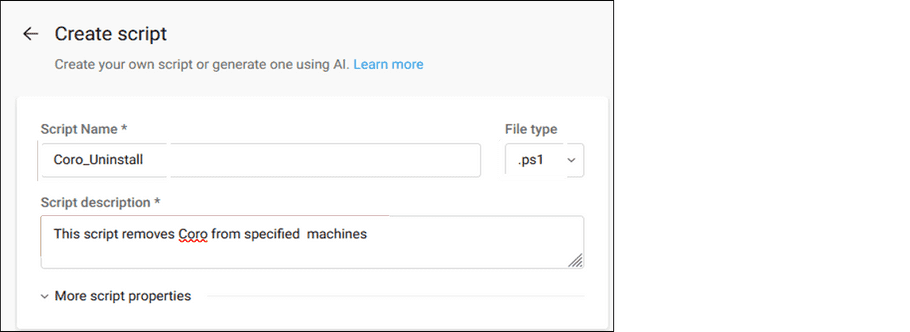
-
Expand
More script properties
, and then enter the following additional script information:
Field Description Category Leave blank. Max script run time (minutes) Enter "10". Arguments Leave blank. Run as Select System. 
-
Copy and paste your
Coro uninstall script
into the
Script editor
:
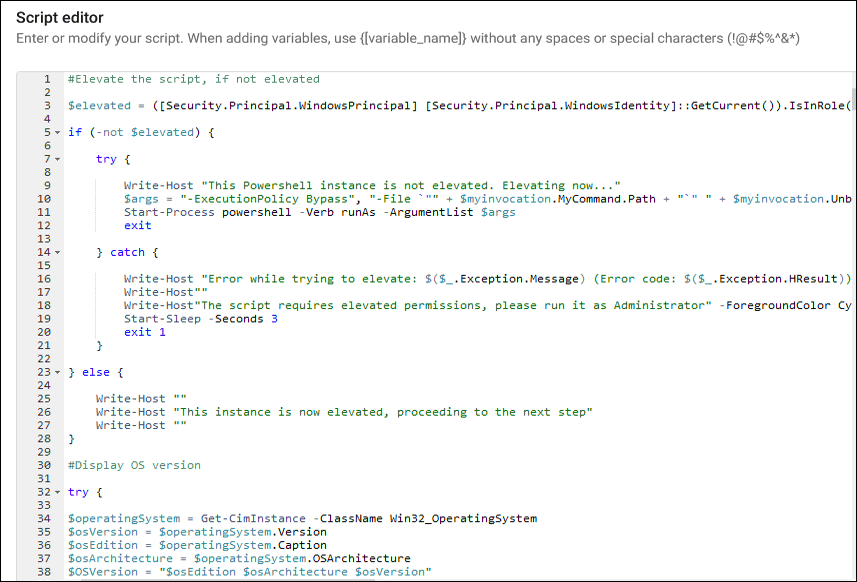
-
Select
Create
:

Atera creates the uninstall script, and it appears on the My Scripts tab on the Scripts page ready for deployment:

Uninstalling the Coro Agent
To uninstall the Coro Agent from selected endpoint devices using the uninstall script, perform the following steps:
- Sign into the Atera RMM platform using an administrator account.
-
Go to
Devices
:

A list of all devices appears.
-
From the
My Scripts
tab, select the checkbox next to each device from which you want to uninstall the Coro Agent, and then select
Run Script
:

The Run script on devices dialog appears:

-
Select
Run
, located next to the Coro uninstall script:

The uninstall script executes and a notification appears:

-
To monitor the progress of the script deployment, go to
Reports
>
Classic Reports
>
Recent Processes
:

The Current Status displays "In Progress":

The Coro Agent is removed from the selected devices.
After script deployment, the Current Status changes to "Ended".
-
Hover over
?
to view the script deployment result:

A result of 1 Completed confirms successful deployment.